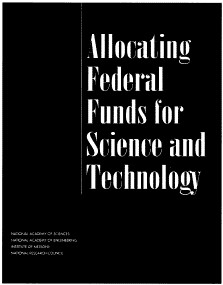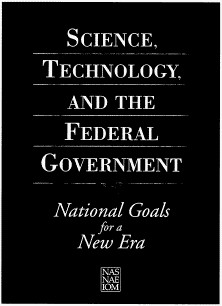government needs to recruit exceptionally able scientists and engineers into its top policy positions to weigh the advice of technical specialists and make key programmatic and policy decisions. (E-2) Disincentives to serve in top positions—for example, unreasonable postgovernment-employment restrictions and inappropriate conflict-of-interest proscriptions—can seriously impede the government’s ability to maintain effective policies in science and engineering research.
A particularly important position is that of the president’s adviser for science and technology. As was done at the beginning of the Clinton administration, the early designation of the president’s adviser for science and technology enables the president to call on this person in recruiting highly qualified appointees to science and technology positions in the federal government. Cabinet secretaries and agency heads also can play important recruitment roles.
|
For more information on scientists and engineers in the federal workforce:
|
Toward the Future
Leadership in the 21st century will belong to those nations that can capitalize best on change, and science and engineering research has become the most powerful force for change in our society. A strong research capacity will also allow us to deal with a large variety of future challenges, whether national-security threats, environmental problems, medical or public-health emergencies, or crises that we cannot yet predict. Solutions to pressing problems will continue to emerge in unexpected ways from new knowledge.
In summary, our capacity for problem-solving and creative discovery will continue to be essential for keeping the United States in its world leadership position economically, militarily, and intellectually. Prudent stewardship of science and engineering research, as much as any other component of government policy, will dictate how our children and grandchildren will live.
|
For Further Information: The World Wide Web site http://www2.nas.edu/21st includes up-to-date versions of all the documents in this series and on-line versions of the reports referred to in this document. Internet Address: jjensen@nas.edu Phone: (202) 334–1601 Fax: (202) 334–2419 Address: National Research Council Office of Congressional and Government Affairs 2101 Constitution Avenue, NW Washington, DC 20418 |
© 1997 by the National Academy of Sciences. All rights reserved. This document may be reproduced solely for individual, non-commercial, and educational purposes without the written permission of the National Academy of Sciences.
RECENT SCIENCE AND TECHNOLOGY POLICY REPORTS

WEB SITE:
http://www.nap.edu/readingroom/books/fedfunds

WEB SITE:
|
The National Academy of Sciences (NAS) is a private, nonprofit, self-perpetuating society of distinguished scholars engaged in scientific and engineering research, dedicated to the furtherance of science and technology and to their use for the general welfare. Under the authority of the charter granted to it by Congress in 1863, the Academy has a working mandate that calls on it to advise the federal government on scientific and technical matters. Dr. Bruce M.Alberts is president of the NAS. The National Academy of Engineering (NAE) was established in 1964, under the charter of the NAS, as a parallel organization of distinguished engineers. It is autonomous in its administration and in the selection of members, sharing with the NAS its responsibilities for advising the federal government. The National Academy of Engineering also sponsors engineering programs aimed at meeting national needs, encourages education and research, and recognizes the superior achievements of engineers. Dr. William A.Wulf is interim president of the NAE. The Institute of Medicine (IOM) was established in 1970 by the NAS to secure the services of eminent members of appropriate professions in the examination of policy matters pertaining to the health of the public. The Institute acts under the responsibility given to the NAS in its congressional charter to be an adviser to the federal government and, on its own initiative, to identify issues of medical care, research, and education. Dr. Kenneth I.Shine is president of the IOM. The National Research Council (NRC) was organized by the NAS in 1916 to associate the broad community of science and technology with the Academy’s purposes of furthering knowledge and advising the federal government. Functioning in accordance with general policies determined by the Academy, the Council has become the principal operating agency of both the NAS and the NAE in providing services to the government, the public, and the scientific and engineering communities. The Council is administered jointly by both Academies and the IOM. Dr. Bruce M.Alberts is chairman and Dr. William A.Wulf is interim vice-chairman of the NRC. |



